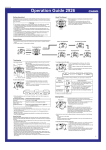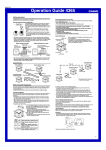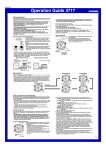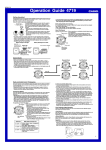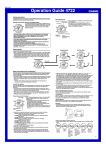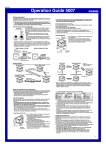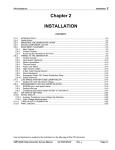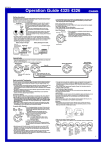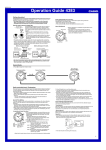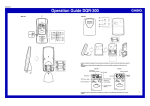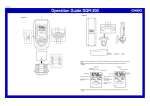Download Casio Watch MO0503-EA User's Manual
Transcript
MO0503-EA Operation Guide 3723 3724 Getting Acquainted Congratulations upon your selection of this CASIO watch. To get the most out of your purchase, be sure to read this manual carefully and keep it on hand for later reference when necessary. Bright light l l l l l l l l l l l Keep the watch exposed to bright light Solar cell The electricity generated by the solar cell of the watch is stored by a built-in battery. Leaving or using the watch where it is not exposed to light causes the battery to run down. Make sure the watch is exposed to light as much as possible. • When you are not wearing the watch on your wrist, position the face so it is pointed at a source of bright light. • You should try to keep the watch outside of your sleeve as much as possible. Even if the face of the watch is only partially blocked from light, charging will be reduced significantly. • The watch continues to operate, even when it is not exposed to light. Leaving the watch in the dark can cause the battery to run down, which will cause some watch functions to be disabled. If the battery goes dead, you will have to re-configure watch settings after recharging. To ensure normal watch operation, be sure to keep it exposed to light as much as possible. Battery charges in the light. Solar cell (Converts light to electrical power.) • The actual level at which some functions are disabled depends on the watch model. • Frequent display illumination can run down the battery quickly and require charging. The following guidelines give an idea of the charging time required to recover from a single illumination operation. Approximately 5 minutes exposure to bright sunlight coming in through a window Approximately 50 minutes exposure to indoor fluorescent lighting • Be sure to read “Power Supply” for important information you need to know when exposing the watch to bright light. If the analog hands aren’t moving... If the analog hands aren’t moving, it means that the power saving mode has stopped them to save battery power. • See “Power Saving” for more information. About This Manual Hour hand Minute hand • Button operations are indicated using the letters shown in the illustration. • Each section of this manual provides you with the information you need to perform operations in each mode. Further details and technical information can be found in the “Reference” section. Battery discharges in the dark. Bright light Electrical energy Date LEVEL 1 LEVEL 2 Second hand All functions enabled LEVEL 1 Dis- LEVEL 2 charge LEVEL 3 Charge LEVEL 3 Some functions disabled Rechargeable battery General Guide • Press B to change from mode to mode. • In the Timekeeping Mode, press A to illuminate the face of the watch. Timekeeping Mode Home Position Adjustment Mode Alarm Mode Receive Result Mode Press B. ▲ ▲ ▲ ▲ Radio-controlled Timekeeping This watch receives a time calibration signal and updates its time setting accordingly. The time calibration signal includes both Standard Time and Daylight Saving Time (summer time) data. • This watch is designed to pick up the time calibration signal transmitted in Germany (Mainflingen) and England (Rugby). Current Time Setting This watch adjusts its time setting automatically in accordance with a time calibration signal. You can also perform a manual procedure to set the time and date, when necessary. • The first thing you should do after purchasing this watch is to specify your Home Time Zone, which is the time zone where you will normally use the watch. For more information, see “To specify your Home Time Zone” below. • When using the watch outside the range of the Germany and England time signal transmitters, you have to adjust the current time setting manually as required. See “Timekeeping” for more information about manual time settings. To specify your Home Time Zone 1. In the Timekeeping Mode, hold down A for about five GMT differential seconds until the second hand moves to the currently value (+0) selected GMT differential value and stops. This is the GMT differential setting mode. value (+1) • The GMT differential value indicates the time difference in hours between Greenwich Mean Time and the currently selected time zone. 2. Press B to select the time zone you want to use as your Home Time Zone. GMT+ 0 (12 o’clock): London GMT+ 1 (1 o’clock): Paris, Berlin, Milan, Rome, Amsterdam, Hamburg, Frankfurt, Vienna, Barcelona, Madrid 3. Press A eight times to exit the setting mode. • The watch will also return to the Timekeeping Mode if you do not perform any operation for about two or three minutes. • Normally, your watch should show the correct time as soon as you specify your Home Time Zone. If it does not, it should adjust automatically after the next auto receive operation (in the middle of the night). You can also perform manual receive or you can set the time manually. • Even if the time calibration signal is received correctly, there are some times when the analog hands may not indicate the correct time. If this happens, use the procedures under “Adjusting the Home Positions” to check the home positions of the hands, and make adjustments as required. • The watch will receive the time calibration signal automatically from the applicable transmitter (in the middle of the night) and update its settings accordingly. For information about the relationship between time zones (GMT differential values) and transmitters, see “Transmitters”. • See the maps under “Reception Ranges” for information about the reception ranges of the watch. Time Calibration Signal Reception There are two different methods you can use to receive the time calibration signal: auto receive and manual receive. • Auto Receive With auto receive, the watch receives the time calibration signal automatically up to six times a day. When any auto receive is successful, the remaining auto receive operations are not performed. For more information, see “About Auto Receive”. • Manual Receive Manual receive lets you start a time calibration receive operation with the press of a button. For more information, see “To perform manual receive”. Important! • When getting ready to receive the time calibration signal, position the watch as shown in the nearby illustration, with its 9 o’clock side facing towards a window. Make sure there are no metal objects nearby. 9 o’clock or • The watch should not be facing the wrong way. • Proper signal reception can be difficult or even impossible under the conditions listed below. Inside or among buildings Inside a vehicle Near household appliances, office equipment, or a mobile phone Near a construction site, airport, or other sources of electrical noise Near hightension power lines Among or behind mountains • Signal reception is normally better at night than during the day. • Time calibration signal reception takes from two to seven minutes, but in some cases it can take as long as 14 minutes. Take care that you do not perform any button operations or move the watch during this time. • When within range of the applicable transmitter, this watch can receive either the Germany (Mainflingen) or England (Rugby) time calibration signals. See “Transmitters” for more information. 1 Operation Guide 3723 3724 Signal Reception Troubleshooting Check the following points whenever you experience problems with signal reception. Reception Ranges 1,500 kilometers Rugby 500 kilometers Mainflingen • Under good reception conditions, signal reception is possible within a radius of about 1,500 kilometers from a transmitter. • At distances further than about 500 kilometers from a transmitter, signal reception may not be possible during certain times of year or times of day. Radio interferance may also cause problems with reception. • See the information under “Signal Reception Troubleshooting” if you experience problems with time calibration signal reception. About Auto Receive The watch receives the time calibration signal automatically up to six times a day. When any auto receive is successful, the remaining auto receive operations are not performed. The reception schedule (calibration times) depends on your currently selected Home Time Zone, and whether standard time or Daylight Saving Time is selected for your Home Time Zone. Your Home Time Zone Problem Probable Cause What you should do The second • You changed the time setting • Perform manual signal hand is manually. receive or wait until the next pointing at N. • The watch was not in the auto signal receive operation Timekeeping Mode, or you performed is performed. • Check to make sure the some button operation during the watch is in a location where it auto receive operation. can receive the signal. • Signal reception results are reset at midnight each day. Time setting is • The Home Time Zone setting is not • Select the correct Home correct for the area where you are incorrect Time Zone. following signal using the watch. reception. • For further information, see “Important!” under “Time Calibration Signal Reception” and “Radio-controlled Timekeeping Precautions”. Alarm OFF ON Auto Receive Start Times 1 2 3 4 5 6 To set an alarm time 1. In the Alarm Mode, hold down A for five seconds to display the setting mode. • The second hand will move to AM or PM. 2. Use A and B to change the alarm time. • Press B to move the hands clockwise in one-minute steps. GMT +0 Standard Time 1:00 am 2:00 am 3:00 am 4:00 am 5:00 am Midnight Daylight Saving Time 2:00 am 3:00 am 4:00 am 5:00 am Midnight 1:00 am next day GMT +1 Standard Time 2:00 am 3:00 am 4:00 am 5:00 am Midnight 1:00 am next day Daylight Saving Time 3:00 am 4:00 am 5:00 am Midnight 1:00 am 2:00 am next day next day Note • The auto receive operation is performed only if the watch is in the Timekeeping Mode when one of the calibration times is reached. It is not performed if a calibration time is reached while an alarm is sounding, or while you are configuring settings. • Auto receipt of the calibration signal is designed to be performed early in the morning, while you sleep (provided that the Timekeeping Mode time is set correctly). Before going to bed for the night, remove the watch from your wrist, and put it in a location where it can receive the signal easily. • The watch receives the calibration signal for two to seven minutes everyday when the time in the Timekeeping Mode reaches each of the calibration times. Do not perform any button operation within seven minutes before or after any one of the calibration times. Doing so can interfere with correct calibration. • Remember that reception of the calibration signal depends on the current time in the Timekeeping Mode. The receive operation will be performed whenever the display shows any one of the calibration times, regardless of whether or not the displayed time is actually the correct time. To perform manual receive 1. Place the watch on a stable surface so its 9 o’clock side is facing towards a window. 2. In any mode, hold down B for about two seconds until the watch beeps. 3. When you release B, the second hand will move to READY to indicate that the watch is setting up for time calibration reception. • The second hand will move to WORK and stay there while actual reception is in progress. WORK READY • The hour and minute hands continue to keep time normally. • Time calibration signal reception takes from two to seven minutes, but in some cases it can take up to 14 minutes. Take care that you do not perform any button operations or move the watch during this time. • If reception is successful, the second hand will move to Y (Yes). One or two minutes later, the hands will move to N (No) Y (Yes) the correct time. Note • To interrupt a receive operation and return to the Timekeeping Mode, press any button. • If reception is not successful, the second hand will move to N (No). One or two minutes later, the second hand will resume normal operation, without any adjustment of the hand setting. • If the second hand is pointing to Y or N, you can return to the Timekeeping Mode by pressing any button. Viewing the Latest Signal Reception Results You can use the Receive Result Mode to check if signal reception was performed correctly. To check the latest signal reception results Enter the Receive Result Mode. • If the watch was able to perform a successful signal receive operation since midnight, the second hand will move to Y (Yes). If the watch has been unable to receive any signal successfully, the second hand will move to N (No). • To return to the Timekeeping Mode, press B three times. • The current receive result is cleared when the first auto receive operation is performed on the following day. This means Y indicates successful signal reception since the N (No) Y (Yes) start of the current day. • Y continues to be indicated even if an attempt at manual receive fails after auto receive is successful. • If you adjust the time or date setting manually, the second hand will move to N. When the alarm is turned on, the alarm sounds when the alarm time is reached. • All of the operations in this section are performed in the Alarm Mode, which you enter by pressing B. • When you enter the Alarm Mode, the second hand will move to either ON (alarm on) or OFF (alarm off), and the hands will move to the current alarm time setting. • To move the hands back, press A. After that, each press of B will move the hands counterclockwise in one-minute steps. • Once you use the above operation to change to counterclockwise hand movement, pressing A will not change back to clockwise hand movement. Pressing A during counterclockwise hand movement will exit the setting mode. To use clockwise hand movement again, you will need to exit the setting mode and restart this procedure from step 1. • When setting the alarm time, take care to set AM and PM correctly. The second hand will move between AM and PM any time the hour hand moves past 12 o’clock while you are setting the alarm time. 3. After setting the alarm time, press A as many time as necessary to exit the setting mode. • If you set the alarm time using clockwise hand movement only, press A twice to exit the setting mode. • If you set the alarm time using counterclockwise hand movement, press A once to exit the setting mode. • This will cause the hour and minute hands to move to the current time, and the second hand to move to ON (alarm on). • Setting the alarm time causes the alarm to turn on automatically. Alarm Operation The alarm tone sounds at the preset time for 10 seconds, regardless of the mode the watch is in. • Alarm operations are performed in accordance with the Timekeeping Mode time. • Pressing any button stops the alarm tone operation. To turn an alarm on and off In the Alarm Mode, press A to toggle the alarm ON and OFF. Adjusting the Home Positions If the time and date settings are wrong even after the time calibration signal is received normally, use the following procedure to adjust their home positions. To adjust the home positions 1. Enter the Home Position Adjustment Mode. 12 o’clock • If the home position of the second hand is currently correct, it will move to the 12 o’clock position. 2. While in the Home Position Adjustment Mode, hold down A for about five seconds. This will cause the second hand to make one revolution and stop at its current home position. • The analog hands do not keep time during home position adjustment. 3. Check the position of the second hand. • The second hand home position is correct if it is pointing at 12 o’clock. Correct second hand • If the second hand is not pointing at 12 o’clock, it home position means that its home position is off. If this happens, 12 o’clock press B to move the second hand clockwise in onesecond steps, until it points at 12 o’clock. 4. Press A to advance to hour and minute hand home position adjustment. • If current hour and minute hand alignment is correct, they will both move to 12 o’clock. 5. Check the position of the hour and minute hands. • If the hour and minute hands are not pointing at 12 o’clock, it means that their home position is off. If this happens, press B to move the hour and minute hands clockwise in 10-second steps, until they point Correct hour at 12 o’clock. and minute hand • You can change the hour and minute hand movement home position direction to counterclockwise by pressing A. After that, each press of B will move the hour and minute hands counterclockwise in 10-second steps. 2 Operation Guide 3723 3724 Illumination indicator Correct date home position 6. Press A to advance to date home position adjustment. • The date indicator will show if the date home position is correct. Note that it can take up to 90 seconds before appears. 7. Check the date indicator. 8. If the date indicator shows something other than , it means that the date home position is off. If this happens, press B to advance the date until appears. • is located between 31 and 1. 9. Press A to exit home position adjustment. • This causes the date to change to the current date, and the hour and minute hands to move to the current time. • Note that all button operations are disabled while the date is changing, and the hour and minute hands are moving. • To return to the Timekeeping Mode, press B. • After you complete the home position adjustment procedure, place the watch in a location that allows good time calibration signal reception, and then perform a manual receive operation. See “To perform manual receive” for more information. Timekeeping Use the Timekeeping Mode to set and view the current time and date. This section also explains how to set the current date and time manually. • If you become confused and lose your way during the following procedures, simply put the watch down and do not perform any button operation for two or three minutes. This will cause the watch to enter the Timekeeping Mode (indicated by normal one-second movement of the second hand) automatically. After that, you can try performing the manual setting procedure again from the beginning. • All of the operations in this section are performed in the Date Timekeeping Mode, which you enter by pressing B. Second hand To set the time and date manually 1. In the Timekeeping Mode, hold down A for about five GMT GMT seconds. differential differential value (+0) value (+1) • This will cause the second hand to move to 12 o’clock, 1 o’clock, or 2 o’clock, depending on the currently GMT selected GMT differential setting. This is the setting mode. differential • The GMT differential value indicates the time difference in value (+2) hours between Greenwich Mean Time and the currently selected time zone. • The hour and minute hands do not move in the setting mode. 2. Press A to cycle through settings in the sequence shown below. Hold down A. Timekeeping Mode Year (1’s Digit) Year (10’s Digit) Hour/Minutes (Forward) Month Day Hour/Minutes (Back) Seconds • Pressing B while the seconds setting is selected will cause the second hand to move to 00 seconds. This also advances the minute by one, resets the seconds count to 00, and exits the setting mode automatically. • If you want to change the year, month, and day setting after resetting the seconds, re-enter the setting mode from step 1. Dec Nov Jan F OF ON AL M Feb Y Mar Aug N Jul Apr RC May Jun Setting the Month 0 1 F OF 2 ON AL M 3 Y 9 8 N 7 6 About the Auto Light Switch Turning on the auto light switch causes the face to illuminate about for one second, whenever you position your wrist as described below in any mode. Note that this watch features a “Full Auto LED Light”, so the auto light switch operates only when available light is below a certain level. It does not illuminate the face under bright light. Moving the watch to a position that is parallel to the ground and then tilting it towards you at more than 40 degrees causes illumination to turn on. • Wear the watch on the outside of your wrist. 4 RC 5 Setting the Year To do this: Change the day Change the month Change the year Parallel to ground More than 40° Warning! • Always make sure you are in a safe place whenever you are reading the face of the watch using the auto light switch. Be especially careful when running or engaged in any other activity that can result in accident or injury. Also take care that sudden illumination by the auto light switch does not startle or distract others around you. • When you are wearing the watch, make sure that its auto light switch is turned off before riding on a bicycle or operating a motorcycle or any other motor vehicle. Sudden and unintended operation of the auto light switch can create a distraction, which can result in a traffic accident and serious personal injury. To turn the auto light switch on and off In the Receive Result Mode, hold down A for about three seconds to toggle the auto light switch on and off. • You can check the current auto light switch on/off setting by pressing A while in the Receive Result Mode. If the face of the watch illuminates when you press A, it means that the auto light switch is on. The auto light switch is off if the face does not illuminated when you press A. Power Supply Press A. GMT Differential Value 3. Select the setting you want to change, and then use B to change it as shown below. To do this: While the second hand is here: Do this: Change the time zone 12 o’clock (GMT+0), 1 o’clock Use B (+). (GMT+1), or 2 o’clock (GMT+2) AM or PM Move the hour and minute hands Use B (+). clockwise one minute Move the hour and minute hands AM or PM Use B (–). counterclockwise one minute Reset the seconds to 00 SEC Press B. Sep To illuminate the face of the watch In the Timekeeping Mode (except for the setting mode), press A to illuminate the face of the watch about for one second. • The above operation turns on illumination regardless of the current auto light switch setting. Minute hand Hour hand Oct An LED (light-emitting diode) illuminates the face of the watch for easy reading in the dark. The watch’s auto light switch automatically illuminates the face when you angle the watch towards your face. • The auto light switch must be turned on for it to operate. • See “Illumination Precautions” for other important information. While the second hand is here: Do this: Use B (+). 12 o’clock Current month 10’s digit of current year 1’s digit of current year • When setting the day, the watch automatically will skip days (30 and 31) that are not included in the currently selected month. If you can’t select 30 or 31 when you want to, check to make sure that the proper month is selected. 4. After setting the 1’s digit of the year, press A to exit the setting mode. • This will cause the hands to move to the current time, and resume normal movement. • Make sure that you set the time correctly as AM or PM (as indicated by the second hand) when setting the time. The second hand will move between AM and PM any time the hour hand moves past 12 o’clock while you are setting the time. This watch is equipped with a solar cell and a special rechargeable battery (secondary battery) that is charged by the electrical power produced by the solar cell. The illustration shown below shows how you should position the watch for charging. Solar cell Example: Orient the watch so its face is pointing at a light source. • The illustration shows how to position a watch with a resin band. • Note that charging efficiency drops when any part of the solar cell is blocked by clothing, etc. • You should try to keep the watch outside of your sleeve as much as possible. Even if the face of the watch is blocked from light only partially, charging will be reduced significantly. Important! • Storing the watch for long periods in an area where there is no light or wearing it in such a way that it is blocked from exposure to light can cause rechargeable battery power to run down. Make sure that the watch is exposed to bright light whenever possible. • This watch uses a special rechargeable battery to store power produced by the solar cell, so regular battery replacement is not required. However, after very long use, the rechargeable battery may lose its ability to achieve a full charge. If you experience problems getting the special rechargeable battery to charge fully, contact your dealer or CASIO distributor about having it replaced. • Never try to remove or replace the watch’s special battery yourself. Use of the wrong type of battery can damage the watch. • The current time and all other settings return to their initial factory defaults whenever battery power drops to Level 3 and when you have the battery replaced. • Keep the watch in an area normally exposed to bright light when storing it for long periods. This helps to keep the rechargeable battery from going dead. Battery Power Levels The movement of the analog hands indicates the current battery power level. Level Hand Movement Function Status 1 Normal. All functions enabled. 2 •Second hand jumps every 2 seconds. •Date changes to home position at midnight. •Second hand stopped. •Hour and minute hands stopped at 12 o’clock. All functions disabled, except for analog timekeeping. 3 All functions disabled. Jumps 2 seconds • The second hand jumping every two seconds (Level 2) indicates that battery power is quite low. Expose the watch to light as soon as possible to charge the battery. • When battery power is at Level 2, time calibration signal reception is disabled. 3 Operation Guide 3723 3724 • At Level 3, all functions are disabled and settings return to their initial factory defaults. The analog hands will move to the current time and normal timekeeping will resume when the battery is recharged sufficiently. • Illumination or alarm operation can cause hand movement to stop due to the sudden temporary drop in battery power. This does not indicate malfunction, and normal operation will resume when the watch is exposed to light. Though hand movement stops, timekeeping continues internally, and the hands will be adjusted to the correct setting when normal operation returns. • If you have problems with proper time calibration signal reception or if the time setting is wrong after signal reception, check your Home Time Zone (GMT differential) setting. The following are the initial factory defaults for this setting. Module 3723: GMT +1.0 Module 3724: GMT +0.0 3723 Charging Precautions • To find out the module number of your watch, look at its back cover. The Module number (3723 or 3724) is engraved inside the box on the back cover. Certain charging conditions can cause the watch to become very hot. Avoid leaving the watch in the areas described below whenever charging its rechargeable battery. Warning! Leaving the watch in bright light to charge its rechargeable battery can cause it to become quite hot. Take care when handling the watch to avoid burn injury. The watch can become particularly hot when exposed to the following conditions for long periods. • On the dashboard of a car parked in direct sunlight • Too close to an incandescent lamp • Under direct sunlight Transmitters This watch is able to receive time calibration signals transmitted in Germany (Mainflingen) and England (Rugby). The following explains how the watch determines which transmitter it should check first. Module 3723 In this case: The watch does this: The first signal search operation after factory default settings are in effect. 1. Checks the Mainflingen signal first. 2. If the Mainflingen signal cannot be received, checks the Rugby signal. 1. Checks the Rugby signal first. 2. If the Rugby signal cannot be received, checks the Mainflingen signal. Charging Guide After a full charge, timekeeping remains enabled for up to about four months. • The following table shows the amount of time the watch needs to be exposed to light each day in order to generate enough power for normal daily operations. The first signal search operation after the Home Time Zone has been changed. Exposure Level (Brightness) Approximate Exposure Time Outdoor sunlight (50,000 lux) 6 minutes In this case: The watch does this: Sunlight through a window (10,000 lux) 30 minutes Daylight through a window on a cloudy day (5,000 lux) 48 minutes The first signal search operation after factory default settings are in effect. Indoor fluorescent lighting (500 lux) 8 hours 1. Checks the Rugby signal first. 2. If the Rugby signal cannot be received, checks the Mainflingen signal. 1. Checks the Rugby signal first. 2. If the Rugby signal cannot be received, checks the Mainflingen signal. The first signal search operation after the Home Time Zone has been changed. • Since these are the specs, we can include all the technical details. • Watch is not exposed to light • Internal timekeeping • Display on 18 hours per day, sleep state 6 hours per day • 1 light operation (1.5 seconds) per day • 10 seconds of alarm operation per day • 1 time calibration reception per day • Stable operation is promoted by frequent charging. Timekeeping Recovery Times The table below shows the amount exposure that is required to take the battery from one level to the next. Exposure Level (Brightness) Approximate Exposure Time Level 3 Level 2 Level 1 ▲ ▲ ▲ Outdoor sunlight (50,000 lux) Sunlight through a window (10,000 lux) Daylight through a window on a cloudy day (5,000 lux) Indoor fluorescent lighting (500 lux) Module 3724 1 hour 12 hours 2 hours 61 hours 3 hours ––– 30 hours ––– • The above exposure time values are all for reference only. Actual required exposure times depend on lighting conditions. Reference This section contains more detailed and technical information about watch operation. It also contains important precautions and notes about the various features and functions of this watch. Auto Return Features • If you leave the watch in the Alarm Mode or Home Position Adjustment Mode for two or three minutes without performing any operation, it returns to the Timekeeping Mode automatically. • If you do not perform any operation for about two or three minutes while a setting mode is selected, the watch will exit the setting mode automatically. Scrolling • The B button is used to change the hand setting in various setting modes. In most cases, holding down the B button will start high-speed movement of the applicable hand(s). • High-speed movement of the hands will continue until it completes a 12-hour cycle, or until you press any button to stop it. Radio-controlled Timekeeping Precautions • Strong electrostatic charge can result in the wrong time being set. • Even when the watch is within the reception range of the transmitter, signal reception will be impossible if the signal is blocked by mountains or other geological formations between the watch and signal source. • Signal reception is affected by weather, atmospheric conditions, and seasonal changes. • The time calibration signal bounces off the ionosphere. Because of this, such factors as changes in the reflectivity of the ionosphere, as well as movement of the ionosphere to higher altitudes due to seasonal atmospheric changes or the time of day may change the reception range of the signal and make reception temporarily impossible. • Even if the time calibration signal is received properly, certain conditions can cause the time setting to be off by up to one second. • The current time setting in accordance with the time calibration signal takes priority over any time settings you make manually. • The watch is designed to update the date and day of the week automatically for the period January 1, 2000 to December 31, 2099. Setting of the date by the time calibration signal cannot be performed starting from January 1, 2100. • This watch can receive signals that differentiate between leap years and non-leap years. • Though this watch is designed to receive both time data (hour, minutes, seconds) and date data (year, month, day), certain signal conditions can limit reception to time data only. • If you are in an area where proper time calibration signal reception is impossible, the watch keeps time within ±20 seconds a month at normal temperature. • The year can be set in the range of 2000 to 2099. • The watch’s built-in full automatic calendar makes allowances for different month lengths and leap years. Once you set the date, there should be no reason to change it except after you have the watch’s battery replaced or when battery power drops to Level 3. • The date will change automatically when the current time reaches midnight. The date change at the end of the month may take more time than normal. • The current time for all time zones in the Timekeeping Mode is calculated in accordance with the Greenwich Mean Time (GMT) differential of each zone, based on your Home Time Zone time setting. • GMT differential is calculated by this watch based on Universal Time Coordinated (UTC*) data. * UTC is the world-wide scientific standard of timekeeping. It is based upon carefully maintained atomic (cesium) clocks that keep time accurately to within microseconds. Leap seconds are added or subtracted as necessary to keep UTC in sync with the Earth’s rotation. The reference point for UTC is Greenwich, England. Power Saving Power Saving enters a sleep state automatically whenever the watch is left for a certain period in an area where it is dark. The table below shows how watch functions are affected by Power Saving. • There are actually two sleep state levels: “second hand sleep” and “function sleep”. Elapsed Time in Dark Operation 60 to 70 minutes (second hand sleep) Second hand only is stopped, all other functions are enabled. 6 or 7 days (function sleep) • All functions, including analog timekeeping, disabled • Internal timekeeping maintained • Wearing the watch inside the sleeve of clothing can cause it to enter the sleep state. • The watch will not enter the sleep state between 6:00 AM and 10:59 PM. If the watch is already in the sleep state when 6:00 AM arrives, however, it will remain in the sleep state. To recover from the sleep state Perform any one of the following operations. • Move the watch to a well-lit area. • Press any button. • Angle the watch towards your face for reading. Illumination Precautions • The illumination provided by the light may be hard to see when viewed under direct sunlight. • Illumination turns off automatically whenever an alarm sounds. • Frequent use of illumination shortens the battery operating time. Auto light switch precautions • Wearing the watch on the inside of your wrist, movement of your arm, or vibration of your arm can cause frequent activation of the auto light switch and illuminate the face of the watch. To avoid running down the battery, turn off the auto light switch whenever engaging in activities that might cause frequent illumination of the face. • Note that wearing the watch under your sleeve while the auto light switch is turned on can cause frequent illumination of the face and can run down the battery. More than 15 degrees too high • Illumination may not turn on if the face of the watch is more than 15 degrees above or below parallel. Make sure that the back of your hand is parallel to the ground. • Illumination turns off after about one second, even if you keep the watch pointed towards your face. • Static electricity or magnetic force can interfere with proper operation of the auto light switch. If illumination does not turn on, try moving the watch back to the starting position (parallel with the ground) and then tilt it back towards your face again. If this does not work, drop your arm all the way down so it hangs at your side, and then bring it back up again. • Under certain conditions, illumination may not turn on until about one second after you turn the face of the watch towards you. This does not necessarily indicate malfunction of the auto light switch. • You may notice a very faint clicking sound coming from the watch when it is shaken back and forth. This sound is caused by mechanical operation of the auto light switch, and does not indicate a problem with the watch. 4




